By Christina Hernandez
Photograph by Peter Ash Lee
“We’re, like, the most non-designer designers,” says Tina Chang, sitting across from her business partner, Esther Mun, at a coffee shop in downtown Manhattan. Indeed, dressed plainly and carrying items from their unadorned product line, born of a shared philosophy that prohibits “design for the sake of design,” Chang and Mun look less like stylistas than the European tourists and hipsters that populate the tables around them.
Yet since teaming up more than three years ago, Chang, 32, and Mun, 30, who both live in New York, have been building a two-company design empire with a double-barreled mission: To create original products and to bring good design to the masses. Their passion is Start Here, a fledgling product line of linkable notebooks launched in 2007. Little Fury, a design collaborative in which they freelance for outside clients, including Rembrandt toothpaste, pays the bills.
[ad#336]
Before Chang and Mun solidified their partnership in 2005, they’d lived something of parallel lives. Both spent their early years in Korea. When she was 5, Chang moved to the United States with her mother and father, who owned delis and cafeterias in Ohio and Colorado. Mun, whose parents remain in Jeju, Korea, where they run a motel, came to California when she was 10. Both women attended New York’s School of Visual Arts and both, at different times, worked at the design firm Pentagram.
So Chang and Mun had known each other, but never worked together, when they spent one coffee-fueled evening discussing their shared fantasy of creating an original product. They developed a short list of high priorities — functionality, simplicity, practicality, innovation and individuality — that would define their designs and set them apart from their overly-stylized counterparts. Beauty, they decided, would come later. And, even then, it would be subject to a rigorous editing process meant to stamp out “cutesy doodads” and keep their products from appearing “overdone.”
As Chang and Mun hashed out the beginnings of their partnership, they decided to also form a freelance design collaborative. Within months, both women had quit their jobs and Little Fury began in April 2006.
[ad#336]
Their first big break was a yearlong contract with Rembrandt to design the company’s toothpaste containers. The bright white box with clean, simple lines is a stark contrast to the frenzied styles of other toothpaste brands. And while some designers might scoff at designing household products, Chang and Mun say the assignment was perfect for them. The women credit their middle-class upbringings with one of their primary missions — to bring good design to the most mundane objects, even toilet paper. “Good design isn’t a luxury,” Chang said. The paycheck from Rembrandt funded the beginnings of Start Here.
In developing their first original product, Chang and Mun didn’t look farther than their own design medium — paper. Wanting to develop a new notebook, not just another hyper-stylized cover, they studied their own organizational techniques. To keep their sketches and notes in chronological order, the designers often stitched and taped notebooks together, Mun said. With functionality and simplicity in mind, the women developed a line of notebooks that link through a pocket system. “We really kind of let function dictate our design,” Chang says.
The five-by-seven-inch white notebooks have no cover design, no built-in pockets (other than one used for linking), and no gimmicky extras. With so much of modern design about choosing already-created imagery, the designers say they were careful not to inject too much personality into their product. “Everyone has their own creative side and it’s really interesting to bring it out,” Mun says.
[ad#336]
The notebooks, the women say, are as much used by their messy friends as they are by anal-retentive professionals. The notebooks have been stuffed with business cards, with the swatches of a designer, and with church prayers. Only recently did the designers add accessories, like self-adhesive pockets and decorative spines, which have not only a design function, but can be used as organizational tools. “We don’t want to self-impose a system on anybody,” Chang says.
A second line of the notebooks with colored covers was created with the environment in mind, extending their values of simplicity and functionality to product creation. The notebooks are made in the United States with 100 percent recycled paper and non-toxic glue. Their printer uses renewable wind energy and the notebooks are packed for shipment in biodegradable plastic bags.
The designers are developing a new line of tote bags to add to their Start Here collection. The off-white organic bags, which they hope to sell during the holidays, will come with a built-in blue grid design, as well as a needle and thread. The bag’s owner is responsible for sewing on her or his own design. Chang says: “We want the individuals to kind of make it their own.”






